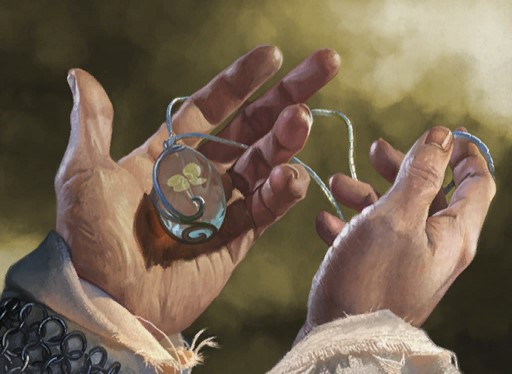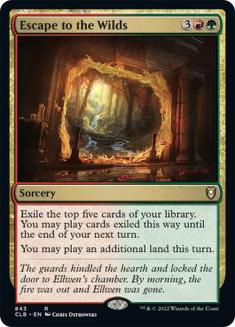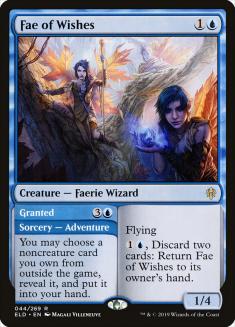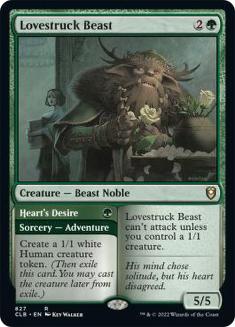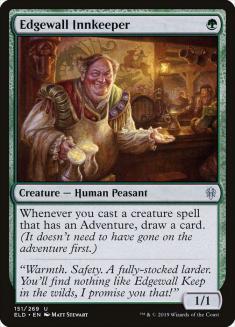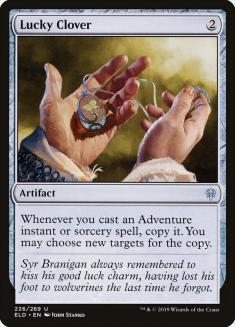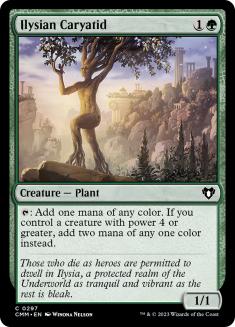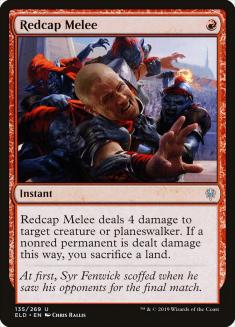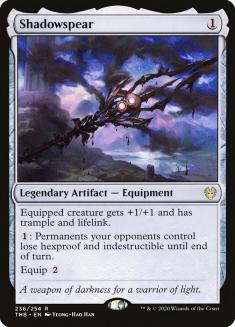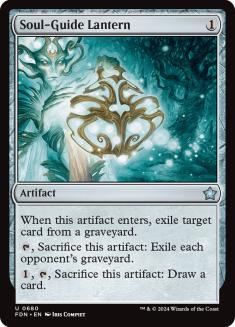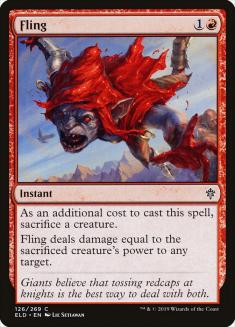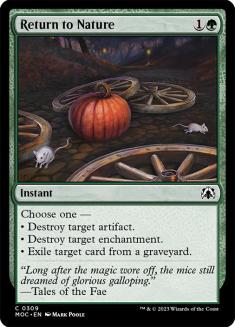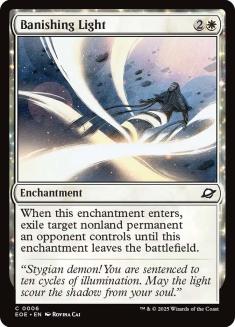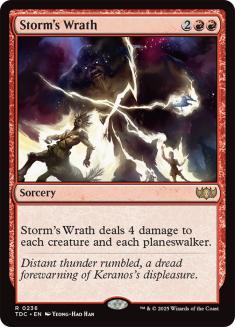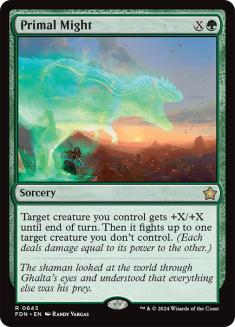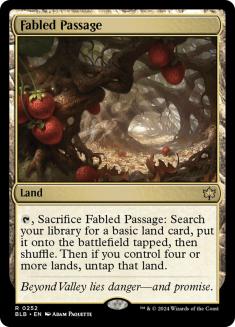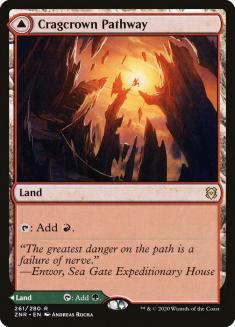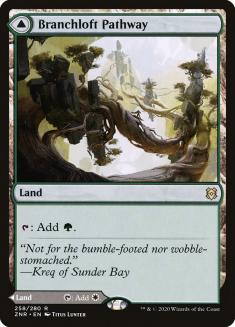It’s an Om or be Om’d world.
Despite still being a bit shaky on the exact list, Four-Color Ramp variants are incredibly popular, making a name for themselves as the go-to best deck. That isn’t to say it’s the only deck available. Players are looking at ways to beat up on a deck with a bunch of chunky spells without a ton of wiggle room between them. One of the easiest ways? Attack.
Creatures (31)
- 3 Scavenging Ooze
- 4 Lovestruck Beast
- 4 Questing Beast
- 4 Robber of the Rich
- 4 Edgewall Innkeeper
- 4 Bonecrusher Giant
- 4 Rimrock Knight
- 4 Kazandu Mammoth
Lands (16)
Spells (13)

Gruul Adventures has been gaining traction as a way to simply push past a deck that’s trying to play in the late phases of the game. After all, the late phases of the game don’t matter if they don’t exist, right? Luckily, I’ve been working on a way to shore up the aggro matchup and beat Four-Color Ramp.
Creatures (24)
- 3 Lovestruck Beast
- 4 Beanstalk Giant
- 4 Edgewall Innkeeper
- 4 Bonecrusher Giant
- 4 Fae of Wishes
- 2 Brazen Borrower
- 3 Omnath, Locus of Creation
Lands (26)
Spells (10)

Remember Temur Adventures from Core Set 2021 Standard? It turns out the only cards that rotated were in the land section and sideboard. What’s relevant about this deck is that it gets to co-opt one of the most powerful portions of the Four-Color Ramp deck, and sink it into its own cards:
A lot of the strength in Four-Color Ramp is in the fact that it never runs out of resources. Rather than being a ramp deck that hopes its one or two payoff cards resolve, it has the luxury of playing a bunch of medium-plus-sized threats that can win a game if left unchecked and largely replace themselves. One of the interactions most illustrative of this point is in the curve of Omnath on Turn 5, followed by a Fabled Passage, which nets a load of mana from Omnath, and then Escape to the Wilds. Nine mana of development and cards on Turn 5, with the looming threat of all the exiled goodies on the following turn.
The functionality of Adventure creatures effectively guarantees that Escape to the Wilds is worth a full five cards, rather than forcing its caster to choose the best one or two cards.
One of the primary draws of this deck is having a much better gameplan against aggressive strategies. Lovestruck Beast on its own can be a house at stymieing early aggression, but having Fae of Wishes and Bonecrusher Giant to also give a bit on Turn 2 as well is just a beating for anything planning to attack early.
The card advantage engines of adventures are the same as they ever were. The key difference is now the most popular answers to these cards, Narset, Parter of Veils and Casualties of War, aren’t quite as legal as they were a few weeks ago. Lucky Clover in particular doesn’t have many answers at the moment, and any game where it’s triggered more than once will be almost impossible for the opponent to keep up.
Another upside of leaning into Adventures: You get fewer of the fragile cards.
Despite cards like Lotus Cobra and Ilysian Caryatid looking powerful on their faces, they’re ultimately squishy mana creatures. Spikefield Hazard ain’t seeing a ton of play for no reason.
The only targets in this deck for small-ball removal are cards that are largely free, in that they were generated with Lovestruck Beast, or can be sequenced in such a way that they’re effectively an Elvish Visionary with upside.
Edgewall Innkeeper is rarely a Turn 1 play in this deck, and that’s because so much for the format is dictated by inevitability rather than early battlefield positioning. Instead, sandbag the card to be a virtual single-green kicker cost on an Adventure creature that immediately draws a card and threatens to draw several more if not answered immediately.
Justifying The Wishboard
Most of the sideboard are cards committed to the Granted portion of Fae of Wishes, and are straightforward. That being said, it’s important to know when to wish for what during each phase of the game, and what bases the cards are covering. Not to mention there are certainly cards that were chosen over other ones, and this is as good a spot as any to explain those decisions:
Having an efficient creature removal spell is necessary, and this is the most mana-efficient way to cover Embercleave and Omnath. Questing Beast is the most awkward card to have to target with Redcap Melee, but in the cases where it’s necessary, Recdap Melee doing a Shard Volley impression hasn’t been too backbreaking.
If you want something less mana-efficient with a higher floor, you can pretty easily put Thundering Rebuke in this slot.
One of the best ways to actually end a game is by putting Shadowspear on Beanstalk Giant. The biggest thing it gets right is that it puts the game out of reach of aggro by virtue of granting lifelink. This slot is one I’m still not entirely sure about and am thinking of putting Embercleave here instead.
As long as people are trying to make Kroxa, Titan of Death’s hunger happen, having a way to embarrass it for a single mana is going to be an effect I’m interested in. Being fairly cheap to cycle in a pinch is also non-trivial.
For a more focused tournament I’d look at making this something like the aforementioned Embercleave, but while laddering, it’s fairly low-cost to have such a powerful effect, and covering more bases is rewarded in an wider field.
Having at least one counterspell that Granted can grab is important. Neutralize is the other realistic option, but most of the spells you’re interested in countering aren’t creatures, and mana efficiency is important. Said efficiency is a common trend in deckbuilding decisions; the deck is so good at using all of its mana that trimming a mana off the costs of cards when possible results in more spell-dense turns over the course of a game.
That doesn’t even get into the fact that these cards only become available once a four-mana spell has been cast. This means that Granted + Neutralize is a seven-mana play, where the same line with Negate is only six. When given that perspective, it becomes a bit easier to understand why shaving mana where possible is important.
The difference between Redcap Melee and Negate versus Thundering Rebuke and Neutralize becomes crystal-clear the first time you cast Granted with a Lucky Clover on the battlefield.
Unfortunately, there isn’t a real Twincast in the format to make the Beanstalk Giant kills easy, but having access to Fling as a way to quickly slam the door shut with an Equipment or Primal Might is nice.
Artifacts are as important as enchantments, so there’s a real cost to trying to optimize this to be something like Mystic Repeal. If the level we’re on is “Having a Disenchant in the sideboard is a good thing, and it needs to be modal,” Return to Nature is simply Disenchant with an extra button.
Banishing Light is the most mana-efficient way to clear a planeswalker. Note that it is fairly risky against decks that have a pile of Ugin, the Spirit Dragon and should be a last resort as a result. That being said, having a nonzero number of this effect is fairly free once the deck dips into white.
One of the most contested slots in the “Wishboard.” Storm’s Wrath is in the deck at this point because it can kill Questing Beast and friends, which is one of the places where the deck is most interested in putting its points into a sweeper rather than spot removal.
If small-ball aggro decks end up becoming more prevalent, there’s a strong argument for having Cinderclasm in that spot.
There’s a strong case for having the fourth copy of Escape to the Wilds in the maindeck and having this slot be some generic value-generating planeswalker. That being said, most of this deck is built to set up very specific curves, and having access to Escape to the Wilds with Granted to set up the “dream” Omnath Turn 5 has been worth it thus far.
The format has mostly adapted to Ugin, but he’s still the biggest bad available in the format, and a slam-dunk pseudo-tutor target as a result.
Primal Might actually occupies a space similar to Redcap Melee most of the time — a one-drop removal spell that teams up with Bonecrusher Giant or Lovestruck Beast to take something down for cheap. The difference is that in the late-game it acts as a pseudo-Fireball when combined with a creature and Fling or Shadowspear.
This is another spot that could simply be Embercleave or another removal spell, but I’ve been happy with Primal Might so far.
Having a land in the sideboard is some last-format technology, but having specifically the card Fabled Passage has been a godsend. On top of being a Prismatic Vista at the phase of the game where Granted actually comes into effect, it sets up the fantastic Turn 5 Omnath + Escape curve that the deck is built to abuse. It’s possible that running some number of Evolving Wilds is correct, but I would put them in the maindeck before I moved the sideboard copy of Fabled Passage.
If you’re looking for another land (and that’s a big if) I would look at Shatterskull Smashing or Evolving Wilds, leaning towards the modal DFC. Having lands that enter the battlefield untapped is a form of trimming mana off lands (after all, lands entering the battlefield tapped is effectively forcing their controller to pay a mana to play them).
The hardest part of playing the deck is easily the mana. Whenever considering what order to sequence lands, consider what the later turns are going to look like, and what they’re going to actually demand (in terms of absolute mana symbols).
For example, casting Omnath and holding up Mystical Dispute is going to cost WUURG. That means that playing an extra red source on Turn 2 or Turn 3 could result in not being able to cast spells on time. After all, the Pathways aren’t “true” multicolor lands but modal “basics.”
Similar to cantrips, the Pathways reward playing them later, rather than earlier. That’s because more cards naturally drawn over the course of the game will inform what the mana requirements of future turns will be, and which lands their owner already has access to. Keep that in mind while sequencing this deck and be very precise about every decision you make.
It’s not easy piloting a deck with upwards of 40 modal spells, with a playset of a card being a thirteen-sided split card. It is, however, rewarding to figure out how to wield a Swiss Army knife in the earlier stages of a format.

